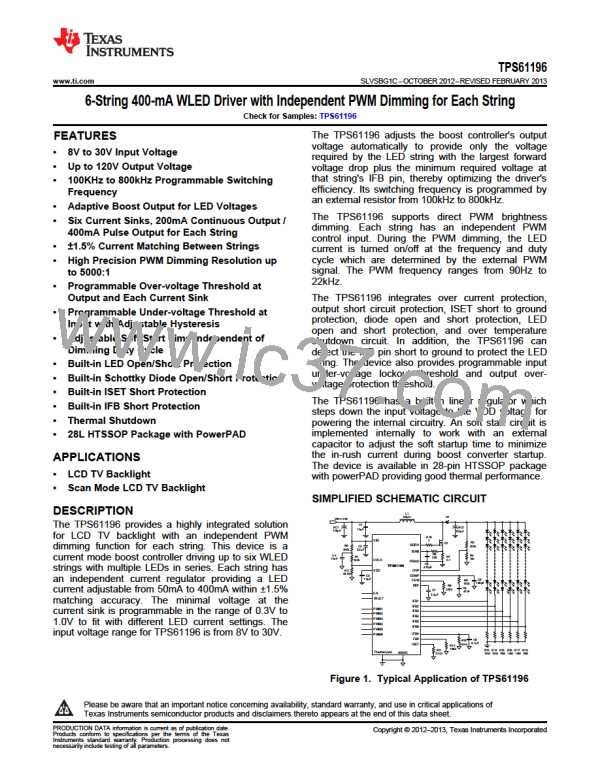TPS61196
SLVSBG1C –OCTOBER 2012–REVISED FEBRUARY 2013
www.ti.com
If the rectifier Schottky diode is shorted, the reverse current from output capacitor to ground is very large
when the switcher MOSFET is turned on. Because the current mode control topology has a minimum edge
blanking time to immunize against the spike current through the switcher, if the parasite inductance between
the output capacitor through the switcher to ground is zero, the external MOSFET will be damaged in this
short period due to the huge power dissipation in this case. But with a small parasite inductance, the power
dissipation is limited. The boost converter works in minimum pulse width in this situation due to cycle by
cycle over-current protection. The output voltage drops and the all-string-open protection is triggered
because of the low voltage at all IFB pins. The TPS61196 is latched off.
6. IFB over-voltage protection during startup
When any of IFB pins reaches the threshold (VOVP_IFB) of 38V during startup, the IC stops switching and
stays in latch-off immediately to protect from damage. In latch-off state, the REF pin voltage is discharged.
7. Output over-voltage protection using the OVP pin
Use a resistor divider to program the maximum output voltage of the boost converter. To ensure the LED
string can be turned on with setting current, the maximum output voltage must be higher than the forward
voltage drop of the LED string. The maximum required voltage can be calculated by multiplying the maximum
LED forward voltage (VFWD(max)) and number (n) of series LEDs , and adding extra 1V to account for
regulation and resistor tolerances and load transients.
The recommended bottom feedback resistor of the resistor divider (R4 in the SIMPLIFIED SCHEMATIC
CIRCUIT) is 10kΩ. Calculate the top resistor (R3, in the SIMPLIFIED SCHEMATIC CIRCUIT) using
Equation 6, where VOVP is the maximum output voltage of the boost converter.
V
æ
ö
OVP
R3 =
-1 ´R4
ç
÷
3.02
è
ø
(6)
When the TPS61196 detects that the voltage at the OVP pin exceeds over voltage protection threshold of
3.02V, indicating that the output voltage has exceeded the clamp threshold voltage, the TPS61196 clamps
the output voltage to the set threshold. When the OVP pin voltage does not drop from the OVP threshold for
more than 500ms, the TPS61196 is latched off until the input power or the EN pin voltage is re-cycled.
8. Output short to ground protection
When the inductor peak current reaches twice the switch current limit in each switching cycle, the IC
immediately disables the boost controller until the fault is cleared. This protects the TPS61196 and external
components from damage if the output is shorted to ground.
9. IFB short to ground protection
The IFB pin short to ground makes the LED current uncontrollable if there is no protection. If the device tries
to increase the boost converter’s output voltage to lift the IFB voltage, it will make the situation worse and the
LED string may be burned due to the high current. The TPS61196 implements a protection mechanism to
protect the LED string in this failure mode.
If the IFB is short to ground before the TPS61196 is turned on, the TPS61196 detects the IFB voltage by
sourcing a 60µA current during startup. If the IFB voltage is less than 0.4V during startup, the startup stops
and the TPS61196 outputs fault indication so as to protect the LED string during start up.
When a LED feedback pin is shorted to ground during normal operation, the TPS61196 first turns off this
LED string for a very short time and detects the IFB voltage again. If the IFB voltage is lower than 1.8V, it
sources a 60µA current and detects the IFB voltage again in off state. If the IFB voltage is still less than
1.8V, this means the IFB pin is shorted to ground. The boost converter is turned off and the REF voltage is
discharged to ground to protect the LED string.
10. ISET short to ground protection
The TPS61196 monitors the ISET pin voltage when the device is enabled. When the sourcing current from
the ISET pin is larger than a threshold of 150μA, the TPS61196 disables the current sink because the ISET
pin may be short to ground or the current setting resistor is too small. Once the current sourcing from the
ISET pin recovers to the normal value, the current sink resumes working.
11. Thermal Protection
16
Submit Documentation Feedback
Copyright © 2012–2013, Texas Instruments Incorporated
Product Folder Links :TPS61196

 TI [ TEXAS INSTRUMENTS ]
TI [ TEXAS INSTRUMENTS ]